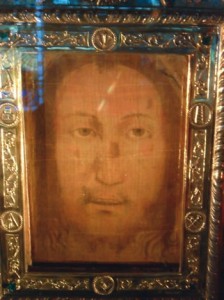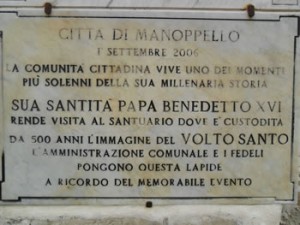The Holy Face of Manoppello
A friend and I recently made a two and a half hour journey from Rome in the direction of Italy’s Adriatic coast, to a small hilltown in the Abruzzo region, called Manoppello. What drew us there is a shrine which is home to a 24cm x 17.5cm cloth which bears an image of the face of Jesus. St John’s gospel (20:7-9) tells the story of Mary Magdalen’s visit to Jesus’ tomb, only to find that the stone had been removed. She went immediately to inform Peter and the beloved disciple, both of whom ran to the tomb, where they discovered that the body of Jesus was no longer present, though they “saw the burial cloths there, and the cloth that had covered his head, not with the burial cloths but rolled up in a separate place.” This cloth that covered the face of Jesus is referred to as the sudarium or the Holy Face.
Christian history and devotion have given a great deal of attention to Jesus’ burial cloth which is known as the Shroud of Turin. But the cloth that covered his face, we have heard very little about. However, the visit to the shrine of Manoppello by Pope Benedict XVI in 2006, aroused interest, so that other pilgrims are following in his footsteps to pay homage to the sacred cloth. Two weeks after his visit, Benedict declared the Church of the Holy Face a minor basilica. As well, a growing number of historians and scientists in the twentieth century have testified that it is the cloth that covered the head of Jesus as he lay in the tomb. We will return to the views of some of these experts later in this article.
What is the history of the sudarium and how did it make its way to a remote place called Manoppello? It seems fairly obvious that after the resurrection of Jesus both clothes were secreted away by some of his close followers and eventually taken afar for their protection. The sudarium first went on display in the early centuries in Cappadocia, at Camulia, near the present Turkish city of Kayseri, eventually being taken to Constantinople in 574, the capital of the Roman Empire. During this time, according to an ancient tradition, this was the sudarium which was placed on the face of Jesus in the tomb, as is recorded in St. John’s Gospel. Because of rising dangers in the Byzantine Empire, the Patriarch sent the cloth to the Pope at the beginning of the eighth century for safe-keeping in St Peter’s where it remained until 1527. 
1527 is the year when the ‘Sack of Rome’ occurred, the Pope first taking refuge in the Castel Sant’Angelo, which today is a tourist venue close to St Peter’s. The Pope eventually fled to Orvieto. It was at this time that many precious objects in St Peter’s were plundered, including the Holy Face or sudarium. One theory is that the sudarium was uplifted from St Peter’s by Ferdinando de Alcaron, who was the commander of the Spanish guards at the Castel, and at the end of the conflict it was taken by him to Abruzzo, sometime between 1608 and 1618. Here he became the Marquis. The sudarium, having been secreted in a number of homes, in 1638 was handed over to the Capuchins in Manoppello where it has been venerated ever since as an acheiropoietos, a Greek word which means ‘not made by man’.
………………..
A closer look at the physical characteristics of the sudarium may help us appreciate its specialness. A great deal of scientific research has been done by a number of experts, including Professor Donato Vittore, who used a high-resolution enlarging scanner to examine the cloth. He said: “I have seen that no pigment of colour can be detected in the spaces between the woven threads. If the image were done by using oil paint, I would imagine that small deposits of colour would be between one thread and the other. I must conclude that this technique was not used on the relic of Manoppello. I also exclude the possibility of water-colour, because the outlines of the eyes and the mouth on the image are so sharp and exact. Water-colour would surely penetrate the fibres in an imprecise manner and therefore would lead to a smudging of the details.”
A further observation is that of Chaira Vigo, from the Sardinian island of Sant’Antioco, an expert in the weaving of byssos or sea silk, and one of the last weavers of this material. She is of the opinion that the fibres in the Veil resemble the silky filaments which certain molluscs secrete in order to attach themselves to hard surfaces. These were used by people of antiquity in the Mediterranean area, to weave cloth. She adds “No one could have artificially created such a detailed portrait on byssus, because the material can only be dyed and not painted upon. The Sacred Icon displays this chromatic change.”
Professor Bruno Sammaciccia confirms that “the cloth of the veil is very sheer, almost non-existent. The features of the Divine Redeemer truly appear life-like….with an expression unable to be reproduced by human artistry, which, over the centuries, has lost none of its effect.” The professor concludes “that the Veil possesses something which defies the laws of nature.”
A more recent study made by Father Heinrich Pfeiffer S.J., a widely-respected German theologian and art historian, says that the image of the Holy Face can be perfectly superimposed on the Shroud of Turin, “showing an extraordinary conformity of one Face to the other.” The conclusion he reached, and it is the opinion of a number of scholars, is that the sudarium is not the work of a painter, but is more likely to be the cloth placed on the face of a man who had been wounded and executed. Furthermore, and this is significant, the face on the Veil of Manoppello and that on the Shroud of Turin belong to the same person. Pfeiffer is convinced that the image on the veil and the one on the shroud were made in the three days going from the burial of Jesus to his resurrection.
The shroud that covered Jesus’ body bears a negative image, and it is more than likely the veil or sudarium lay on top of the shroud over the face of Jesus, and therefore has a positive image imprinted on it. In other words, the shroud is a photographic negative and the face on the veil is a photographic positive.
To conclude this reflection we make our own the words of another pilgrim to Manoppello,, Pope Benedict XVI……
O Holy Face of Christ, light that enlightens the darkness of doubt and sadness, life that has defeated forever the force of evil and death, O inscrutable gaze that never ceases to watch over people, O face concealed in the Eucharistic signs and in the faces of those that live with us, make us God’s pilgrims in this world who await the final encounter when we shall see you, Lord, face to face, and contemplate you forever in heavenly glory. Amen.

 Entries(RSS)
Entries(RSS)